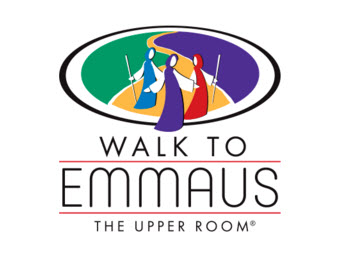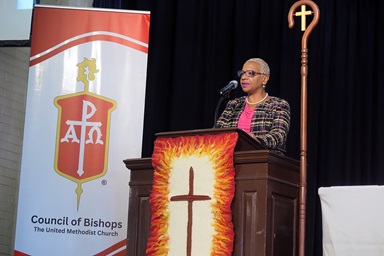Christ shows up in the most unexpected places — in the wisdom of a stranger, in the breaking of bread and even in those moments when all hope seems lost.
That is one lesson from Luke: 24:13-34, the only detailed account of Jesus’ post-resurrection walk to Emmaus. The risen Christ travels about seven miles from Jerusalem alongside two grieving disciples. The two already know the testimony of the women at the empty tomb, but they fail to recognize their teacher until he joins them for a meal.
Here is another lesson from the story: A Christ encounter tends to get people up and moving. After Jesus reveals himself, the disciples rush back to Jerusalem with a fervor that the strangely warmed heart of John Wesley would recognize.
“Weren’t our hearts on fire when he spoke to us along the road and when he explained the Scriptures for us?” the two say to each other.
The familiar Bible story remains cherished Easter reading and, in fact, is one of the possible lectionary passages for Easter Sunday. The account also provides the name of the Walk to Emmaus movement, a ministry of ecumenical spiritual retreats organized through The Upper Room at United Methodist Discipleship Ministries.
Scholars and other Christians see plenty of reasons why the story still resonates with Christ’s followers today.
“The storytelling catches me every time,” said Ryan Schellenberg, a New Testament professor at Methodist Theological School in Ohio. He calls the Walk to Emmaus one of his favorite Bible passages.
“There’s this beautiful irony in the disciples not knowing it when Jesus is walking among them. Then there is this scene of revelation when Jesus reveals himself in the breaking of the bread.”
The passage explains how people in the post-resurrection era come to recognize Christ, said the Rev. Thomas E. Phillips, a New Testament scholar and dean of the library at United Methodist Claremont School of Theology in California.
“They come to recognize Jesus through the opening of the Scripture (24:27) and through the breaking of bread (24:30),” said Phillips, who served as the lead translator for the Gospel of Luke in the Common English Bible (Abingdon, 2010). “That is, Christ is made known to us through preaching and Eucharist.”
Making the Bible cut
The four biblical Gospels each offer slightly different takes on what happened Easter morning and its immediate aftermath. For example, only the Gospel of John recounts Jesus appearing to Mary Magdalene outside the tomb and later appearing to the once-doubting Thomas.
Schellenberg and other scholars believe Luke includes the Emmaus account in his biography of Jesus because it fits well with themes the Gospel writer wants to emphasize.
One of those themes is the importance of table fellowship. Schellenberg noted that in Luke, Jesus reveals himself to be someone “who likes a good banquet.”
As happens when he reaches Emmaus, Jesus often acts as host, even when he is a guest in the house. Jesus is an inclusive host. He feeds the 5,000 with loaves and fishes. He eats with sinners and tax collectors. In Luke, unlike other Gospels, Jesus also eats with the observant Jewish lay leaders known as Pharisees.
“Someone is sitting down and eating with Jesus in almost every chapter of Luke,” Schellenberg said. “So it’s not at all coincidental where Jesus is recognized when he sits at the table with his disciples.”
Another theme the Emmaus story underscores is the importance of the Hebrew Scriptures in understanding who Jesus is, Phillips of Claremont said.
“Jesus (in Luke) is the fulfillment of the whole of the Old Testament — that is, Jesus’s life, death and resurrection complete the overall trajectory of Old Testament hope,” he said. “This is very different than in Matthew where Jesus fulfills the specific verses in the Old Testament.”
In Luke, Jesus takes time to explain Scripture before his disciples can truly see him.
Rethinking the Messiah
Why were the disciples so blind that they could not immediately identify their beloved master? Schellenberg suggests it is because they saw Jesus’ death as the end of God’s plan.
They expected a Messiah who would liberate Israel. They did not expect God’s anointed to suffer. However, as Jesus himself tells his traveling companions, that is what the prophets promised.
“Those who are looking for a glorious Jesus to come and rescue them from their enemies with violence and power might miss the humble Jesus who shows up on the road with them,” Schellenberg said.
He added that Luke’s emphasis on the suffering Messiah is not about the doctrine of atonement — that Christ had to die so human sin could be forgiven. That lesson is elsewhere in the New Testament; Luke had a different interpretation.
“He focused on the fact that what it means to be faithful to God in a world that is addicted to wealth and power and other values that contradict what God’s kingdom is about is necessarily suffering,” the scholar said. “The Messiah must suffer because those who obey God will end up suffering because of the nature of the world. Jesus is the model for what faithfulness to God looks like.”
The Walk to Emmaus Movement

The Upper Room, part of United Methodist Discipleship Ministries, began the three-day ecumenical spiritual-renewal retreats in 1978. The self-supporting ministry grew out of the the Catholic Cursillo movement, and took the name Walk to Emmaus in 1981. The goal of Walk to Emmaus is to equip church members for Christian action. Following the three-day experience, participants are joined in small groups to support each other in their ongoing walk with Christ. The movement also includes the Chrysalis program for youth, the Face to Face program for adults 60 and older, and the Journey to the Table program for adults 18 to 35.
Relating to today’s Christians
Susan E. Hylen, a New Testament professor at United Methodist Candler School of Theology and Emory University’s graduate division of religion in Atlanta, points out that Luke’s resurrection account follows the pattern of Christian worship.
“The story is told, the Scripture is interpreted and then you have the breaking of the bread,” she said. The message is clear: Worship is a way for disciples who never knew Jesus in the flesh to “come to know Christ and get to know him better.”
For Kay Roach, the story reminds her of her experience in a Walk to Emmaus retreat.
“When you are there, you see the face of Jesus,” said Roach, a member of Centenary United Methodist Church in Quincy, Florida. The experience, she said, made her more conscious of her prayer life and a better prayer partner. It also made her more committed to serving others.
Roach is now president of the Florida Conference’s United Methodist Women, but she still finds time to do the nametags for participants in her area’s Walk to Emmaus retreats.
The Rev. Stephane Brooks, director of Walk to Emmaus’ international office, said the ministry operates in 47 countries. Brooks himself first experienced Walk to Emmaus as a seminary student in Jamaica.
Just as Jesus initially appeared before people who were already disciples, the ministry is mainly for people who already are involved in a local church but need their faith reignited, Brooks said. “We want people to embark on a life of prayer, a life of study and a life of action, involvement in the community,” he said.
For Christians, the Walk to Emmaus experience — as recounted in Scripture or encountered in retreats — should be just the beginning of discipleship.
This feature was originally published on March 22, 2016. Heather Hahn is a reporter for United Methodist News Service in Nashville, Tennessee. Contact her at (615) 742-5470 or [email protected].
Like what you're reading? Support the ministry of UM News! Your support ensures the latest denominational news, dynamic stories and informative articles will continue to connect our global community. Make a tax-deductible donation at ResourceUMC.org/GiveUMCom.




